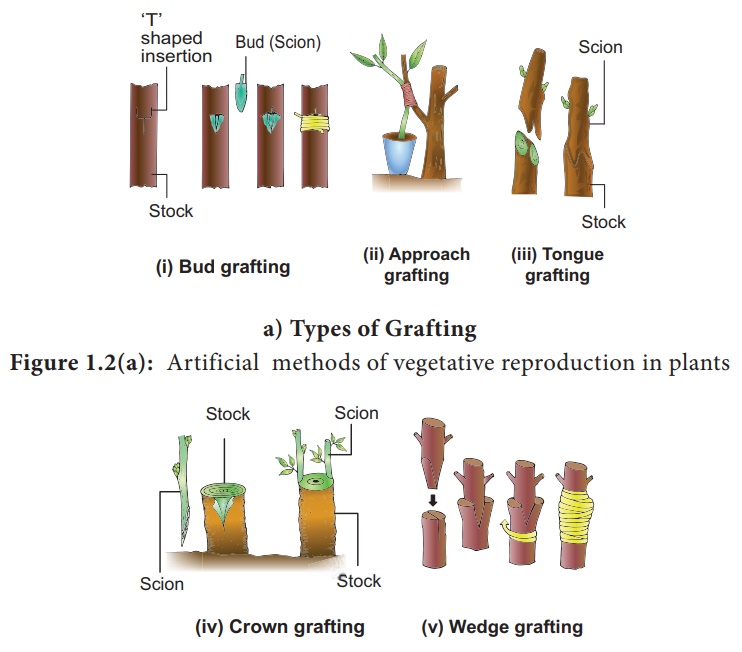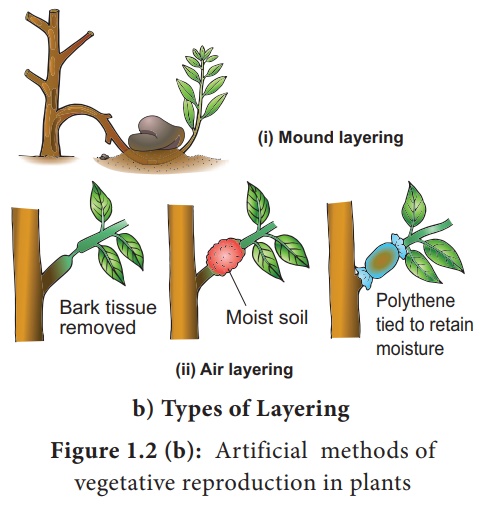Disadvantages and Disadvantages - Vegetative reproduction in Plants - Artificial Vegetative methods | 12th Botany : Chapter 1 : Asexual and Sexual Reproduction in Plants
Chapter: 12th Botany : Chapter 1 : Asexual and Sexual Reproduction in Plants
Artificial Vegetative methods
Artificial Methods
Apart from the above
mentioned natural methods of vegetative reproduction, a number of methods are
used in agriculture and horticulture to propagate plants from their parts. Such
methods are said to be artificial propagation. Some of the artificial propagation
methods have been used by man for a long time and are called conventional
methods. Now-a-days, technology is being used for propagation to
produce large number of plants in a short period of time. Such methods are said
to be modern methods.
A. Conventional methods
The common methods of
conventional propagation are cutting, grafting and layering.
a. Cutting: It is the method of
producing a new plant by cutting the plant parts such as root, stem and
leaf from the parent plant. The cut part is placed in a suitable medium for
growth. It produces root and grows into a new plant. Depending upon the part
used it is called as root cutting (Malus), stem cutting (Hibiscus,
Bougainvillea and Moringa) and leaf cutting (Begonia, Bryophyllum).
Stem cutting is widely used for propagation.
b. Grafting: In this, parts of two
different plants are joined so that they continue to grow as one plant.
Of the two plants, the plant which is in contact with the soil is called stock
and the plant used for grafting is called scion (Figure 1.2 a). Examples
are Citrus, Mango and Apple. There are different types of grafting based on the
method of uniting the scion and stock. They are bud grafting, approach
grafting, tongue grafting, crown grafting and wedge grafting.

i. Bud grafting: A T- shaped incision is
made in the stock and the bark is lifted. The scion bud with little wood
is placed in the incision beneath the bark and properly bandaged with a tape.
ii. Approach grafting: In this method both the
scion and stock remain rooted. The stock is grown in a pot and it is brought
close to the scion. Both of them should have the same thickness. A small slice
is cut from both and the cut surfaces are brought near and tied together and
held by a tape. After 1-4 weeks the tip of the stock and base of the scion are
cut off and detached and grown in a separate pot.
iii. Tongue grafting
A scion and stock having
the same thickness is cut obliquely and the scion is fit into the stock and
bound with a tape.
iv. Crown grafting.
When the stock is large
in size scions are cut into wedge shape and are inserted on the slits or clefts
of the stock and fixed in position using graft wax.
v. Wedge grafting
In this method a slit is
made in the stock or the bark is cut. A twig of scion is inserted and tightly
bound so that the cambium of the two is joined.
c. Layering: In this method, the stem
of a parent plant is allowed to develop roots while still intact. When
the root develops, the rooted part is cut and planted to grow as a new plant.
Examples: Ixora and Jasminum. Mound layering and Air layering are
few types of layering (Figure 1.2 b).

i. Mound layering: This method is applied for the plants having flexible branches. The lower branch with leaves is bent to the ground and part of the stem is buried in the soil and tip of the branch is exposed above the soil. After the roots emerge from the part of the stem buried in the soil, a cut is made in parent plant so that the buried part grow into a new plant.
ii. Air layering: In this method the
stem is girdled at nodal region and hormones are applied to this region
which promotes rooting. This portion is covered with damp or moist soil using a
polythene sheet. Roots emerge in these branches after 2-4 months. Such branches
are removed from the parent plant and grown in a separate pot or ground.
Advantages of conventional methods
·
The plants produced are genetically uniform.
·
Many plants can be produced quickly by this method.
·
Some plants produce little or no seeds; in others, the seeds
produced do not germinate. In such cases, plants can be produced in a short
period by this method.
·
Some plants can be propagated more economically by vegetative
propagation. Example: Solanum tuberosum.
·
Two different plants with desirable characters such as disease
resistant and high yield can be grafted and grown as a new plant with the same
desirable characters.
Disadvantages of conventional methods
·
Use of virus infected plants as parents produces viral infected
new plants.
·
Vegetative structures used for propagation are bulky and so they
are difficult to handle and store.
B. Modern Method
Professor F.C.
Steward(1932) of Cornell University showed that the mature phloem parenchyma
cells removed from the carrot were placed in a suitable medium under controlled
conditions, could be stimulated to start dividing again to produce a new carrot
plant. These cells were described as totipotent. The genetic ability of
a plant cell to produce the entire plant under suitable conditions is said to
be totipotency. This characteristic feature of a cell is utilized in
horticulture, forestry and industries to propagate plants. The growth of plant
tissue in special culture medium under suitable controlled conditions is known
as tissue culture.
Micropropagation
The regeneration of a
whole plant from single cell, tissue or small pieces of vegetative structures
through tissue culture is called micropropagation. This is one of the
modern methods used to propagate plants. The detailed steps involved in
the micropropagation are given in Unit VIII.
Advantages of modern methods
·
Plants with desired characteristics can be multiplied rapidly in a
short duration.
·
Plants produced are genetically identical.
·
Tissue culture can be carried out in any season to produce plants.
·
Plants which do not produce viable seeds and seeds that are
difficult to germinate can be propagated by tissue culture.
·
Rare and endangered plants can be propagated.
·
Disease free plants can be produced by meristem culture.
·
Cells can be genetically modified and transformed using tissue
culture.
Disadvantages of modern methods
·
It is labour intensive and requires skilled workers.
·
Sterile condition must be maintained which adds to the cost.
· Since the clones are genetically identical, the entire crop is susceptible to new diseases or changes in environmental conditions will wipe out the species.
·
Sometimes,callus undergoes genetical changes which are
undesirable for commercial use.
Related Topics